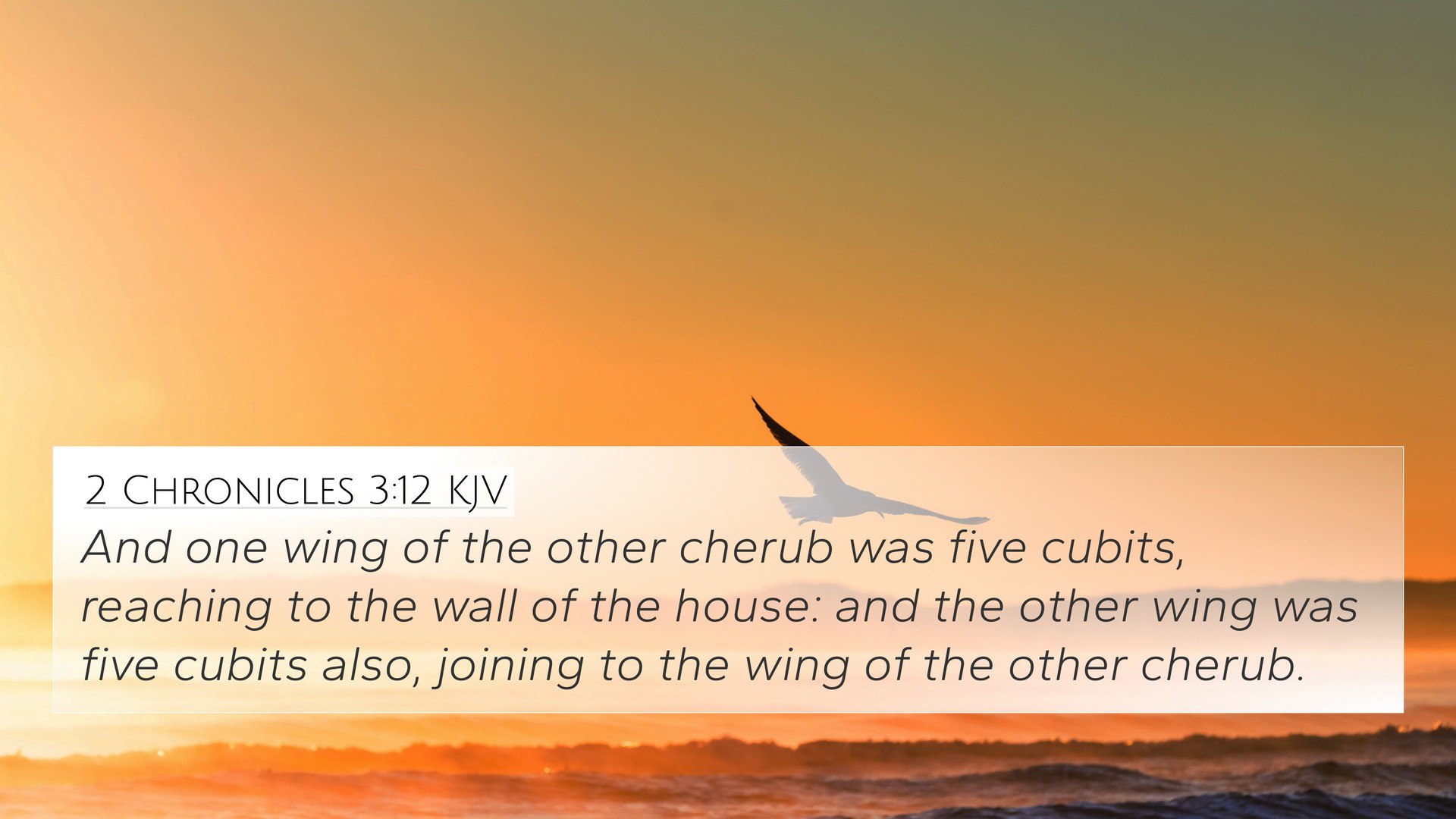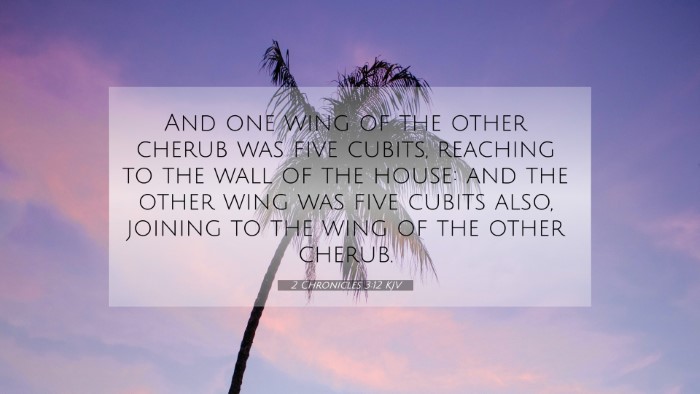Understanding 2 Chronicles 3:12
2 Chronicles 3:12 states: "And one wing of the cherub was five cubits, reaching to the wall of the house: and the other wing was five cubits, joining to the wing of the other cherub."
Overview
This verse is part of the description regarding the construction of Solomon's temple, highlighting the detail and magnificence of the cherubim that adorned the sanctuary. It reflects the sacredness of the space where God would dwell among His people.
Significance of the Verse
The wings of the cherubim are essential for understanding the architectural and symbolic elements of the temple. Here, the emphasis is on measurement and proportion, which illustrates the importance of precision and intent in worship and the design of holy spaces.
Commentary Insights
- Matthew Henry: Henry emphasizes the intentional design behind the temple's architecture, noting that the dimensions of the cherubim symbolize the majesty of God. The wings reaching to the walls suggest God's encompassing presence within the temple.
- Albert Barnes: Barnes explains that the cherubim represent the divine guardianship and presence of God. Their wings stretching to touch one another indicate unity and the connection between heaven and earth, serving as a visual representation of God's throne room.
- Adam Clarke: Clarke describes the cherubim as representations of celestial beings that serve God. He points out that their large size illustrates both their importance and the grandeur of the temple, which was intended as a fitting house for God's glory.
Thematic Connections
This verse plays a crucial role in the broader theme of divine presence in the temple. Here are key connections:
- 1 Kings 6:27: This verse offers parallel details on the placement of cherubim within the inner sanctuary of the temple, affirming their role as protectors of the holy space.
- Exodus 25:18-22: Provides earlier references to cherubim crafted for the mercy seat in the Ark of the Covenant, linking worship and the manifestation of God's presence.
- Psalms 80:1: This psalm mentions God dwelling between the cherubim, reinforcing the significance of these figures in understanding God's protective presence.
- Isaiah 6:2: In this passage, seraphim (similar celestial beings) are described, highlighting the theme of heavenly beings in worship and the holiness of God's presence.
- Ezekiel 10:1-3: Ezekiel's vision elaborates on cherubim and their connection to God's glory, suggesting that they serve as intermediaries between God and humanity.
- Hebrews 9:5: This New Testament reference discusses the cherubim overshadowing the mercy seat, indicating the continuity of the symbolism from the Old to New Testament.
- Revelation 4:6-8: Describes living creatures around God's throne, paralleling the cherubim's role in worship and celestial service.
Cross-Referencing Biblical Texts
In the context of 2 Chronicles 3:12, it is beneficial to recognize various cross-references that enrich our understanding of this verse:
- 1 Chronicles 28:11-12 - Discusses David's instructions on the layout of the temple.
- Matthew 27:51 - The tearing of the temple veil illustrates the new covenant and access to God.
- John 2:19-21 - Jesus refers to the temple as His body, indicating the shift from physical structures to spiritual presence.
- Acts 7:47-50 - Stephen recounts the temple and challenges the notion of God being confined to a structure.
Practical Applications
Understanding this verse highlights several applications for personal and communal worship:
- Recognizing the significance of sacred spaces in our lives and how they reflect our relationship with God.
- Understanding the importance of reverence in worship, as demonstrated by the detailed instructions for God’s dwelling place.
- Emphasizing the connection between the Old and New Testament in understanding God's continuous presence amongst His people.
- Encouraging personal reflection on God's glory and majesty, as represented in the design and purpose of sacred architecture.
Conclusion
2 Chronicles 3:12 serves as a vital link in understanding the structure and purpose of Solomon's temple, reflecting God's desire to dwell among His people and illustrating the broader themes of divine presence and worship. The cherubim symbolize the majesty and holiness of God, serving both as protectors of the sacred space and as a connection between humanity and the divine.


